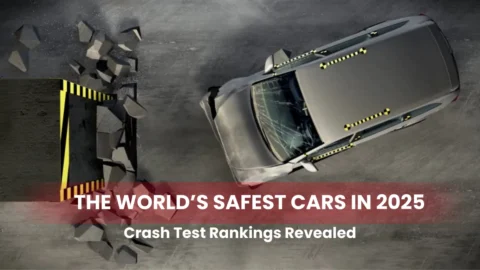As the crisp autumn air gives way to the icy grip of winter, the roads of Hampshire, from the New Forest to the bustling city streets of Southampton and Portsmouth, undergo a dramatic transformation. The combination of coastal dampness, sudden inland frosts, and the notorious ‘black ice’ demands heightened vigilance from drivers.
While most know to check their tyres and anti-freeze, the true test of preparing your car for winter lies in the details —the crucial, but often-ignored the elements of a comprehensive Winter car checklist. Skipping these small but vital steps can transform a minor inconvenience into a major roadside breakdown or, worse, a preventable accident.
This educational and informative guide dives deep into the ultimate Winter car checklist, highlighting seven critical checks that Hampshire drivers frequently overlook. Master these areas, and you’ll not only enhance your car winter safety tips but also ensure a high-engagement, stress-free winter driving experience.
1. The Critical 3mm Tyre Tread Rule
The official legal minimum for tyre tread depth in the UK is 1.6mm. However, in the context of winter driving safety, this minimum is dangerously insufficient. This is the first, most common, and potentially most dangerous oversight in any winter car inspection.
The Hampshire Overlook: Many drivers assume their tyres are fine if they are above the legal 1.6mm. However, once tread depth drops below a tyre’s ability to grip on wet, icy, or snow-covered roads is drastically reduced. In cold, damp conditions typical of the Hampshire coastline and its surrounding areas, this loss of traction is critical.
Make use of a 20p coin. You may be able to see the outer band of the coin, indicating that your tread is likely over 3mm and your tyre’s ability in winter is reduced.
Don’t just check the middle. Tyre wear can be uneven. Inspect the inner and outer edges for wear, which is a common sign that you need new tyres. This is an essential part of your Winter car checklist.
2. The Unseen Power Drain: Battery Health and Testing
A car battery loses up to 50% of its performance capability when the temperature drops, Meanwhile, the demands placed on it increase dramatically more use of lights, heaters, demisters, and wipers.
Drivers often wait for the telltale slow crank on a frosty morning before considering the battery. By then, it’s often too late, leading to an inconvenient and frustrating non-start. The battery’s health is arguably the most important element of winter car maintenance.
Have your battery, alternator, and starter motor professionally tested. Most garages offer this as a free or low-cost car winter inspection service. They check the CCA, which indicates the battery’s ability to start the engine in cold weather. Corrosion can impede current flow, mimicking a flat battery. This small check is a huge step in preparing your car for winter.
3. The Forgotten System: Coolant Concentration and Hoses
Antifreeze is the lifeblood of your engine in winter, protecting the engine block from freezing and cracking. However, coolant is a mix of water and antifreeze, and the balance is key.
Topping up the coolant reservoir with plain water instead of the correct 50/50 water and antifreeze mix. This dilutes the antifreeze, raising the freezing point of the mixture and offering inadequate protection against severe frost. A cracked engine block is an expensive mistake to avoid with proper winter car maintenance.
Use an inexpensive coolant tester hydrometer to check the concentration and ensure it protects against temperatures well below the expected local minimum, which is a key car winter safety tip.
Cold and age make rubber hoses brittle. Squeeze the radiator hoses; they should be firm but pliable. Check for cracks, bulges, or perishing. Also, inspect all hose clips for tightness. Leaking coolant means a rapidly overheating engine which is a big problem in any car winter inspection.
4. Visibility Overlooked: Washer Jet Alignment and Blade Integrity
In winter, the windscreen is assaulted by dirt, salt spray, and rain, demanding perfect wiper performance. While drivers often remember to check the fluid, two crucial components are often forgotten.
Hampshire drivers often neglect to check the wiper blade rubber for small tears or hardening and fail to ensure the washer jets are correctly aimed. A misaligned jet will spray fluid over the roof or bonnet, not the screen, leaving you blind in a spray of road grime which is a serious winter driving safety hazard.
Run the washers and verify the jets are hitting the middle of the windscreen. If not, use a thin needle or pin to gently adjust the nozzle’s angle.
Feel the wiper blade rubber. If it feels brittle or if the wipers leave streaks, replace them immediately. Use dedicated winter-formula washer fluid that contains de-icer; this is a non-negotiable step in preparing your car for winter.
5. The Underrated Lifesaver: Exterior Lights & Lenses
In the dark mornings and short, gloomy days of a British winter, seeing and being seen is paramount. This goes beyond just checking if your bulbs are working.
The plastic lenses on headlights and taillights can become oxidised and yellowed over time. This significantly reduces the light output, meaning a perfectly functioning bulb is effectively useless. Furthermore, many drivers forget to check that their fog lights in both front and rear are working and clean.
Use a dedicated lens restorer kit or a reputable car detailing company to polish cloudy plastic lenses back to crystal clarity. This simple step can dramatically improve your visibility and make you more noticeable to others, drastically increasing winter driving safety.
Ask a friend to walk around the car while you switch on all lights: dipped beam, full beam, brake lights, indicators, and fog lights. Don’t forget your number plate lights! Add this thorough check to your Winter car checklist.
6. The Emergency Kit Oversight: Essential Cold Weather Tools
Preparation is the cornerstone of winter car safety tips. Being stranded in a rural Hampshire lane on a freezing night without the right tools is a terrifying prospect.
Drivers often believe a breakdown won’t happen to them, or they rely only on a mobile phone. However, a poor signal is a reality in parts of the New Forest and South Downs and a flat phone battery can render this useless.
Stock your boot with a dedicated winter emergency kit. Must-have items for cold weather car tips include: a high-vis jacket, a durable ice scraper and brush, a torch with fresh batteries, a blanket/old sleeping bag, high-energy non-perishable food, bottled water, and a fully charged power bank for your phone.
A bag of sand, cat litter, or a set of old car mats can provide essential traction if you get stuck on ice or compacted snow. This is a practical, on-the-spot item often missed in a standard car winter inspection.
7. The Cabin Check: Demister Performance and Air Conditioning
While seemingly a comfort feature, your demister and air conditioning system are crucial winter driving safety tools. They keep the windows clear of condensation and frost.
Many drivers fail to check the efficacy of their demisters both front and rear until they are needed on a foggy morning. Crucially, they forget that air conditioning is used for more than just cooling.
Run your Air Conditioning for at least 10 minutes once a week, even in winter. The A/C system rapidly dehumidifies the air inside the cabin, which is the fastest and most effective way to clear a misted-up windscreen. If the A/C isn’t blowing cold, it’s a sign the refrigerant or compressor needs a check, which is a key part of your winter car maintenance.
Ensure the air vents, particularly those directing air to the windscreen, are free from dust, debris, or any obstructions. This ensures maximum air flow to clear the screen quickly. Proper ventilation is vital for preparing your car for winter.
Things You Might Wonder
While snow is less frequent, winter tyres significantly outperform all-season tyres below 7 degrees Celsius on wet and icy roads—conditions very common in Hampshire. If you regularly drive on untreated rural roads or commute long distances, the improved grip and winter driving safety make them a worthwhile investment as part of your Winter car checklist.
Modern cars do not require extensive idling. It is more effective for your winter car maintenance to start the car and drive gently after about 30-60 seconds. The engine will warm up faster under light load, circulating oil and fluids more quickly. Prolonged idling wastes fuel and is often illegal in certain areas.
Black ice is a thin coating of clear ice on the road surface, making it look black or wet. It’s an extreme car winter safety hazard. If you hit it, do not brake or steer suddenly. Ease off the accelerator gently, keep the steering wheel straight, and allow the car to pass over the ice until your tyres regain traction.
Yes! A clogged or dirty pollen/cabin air filter can severely restrict the air flow into your car’s ventilation system, making your demisters slow and ineffective. Replacing this filter is a simple, often-overlooked step in preparing your car for winter and ensuring quick window clearance.
Yes. Road salt and grit are highly corrosive and can quickly damage your car’s paintwork, underbody, and brake lines. Washing your car regularly throughout winter is a vital, often-forgotten part of winter car maintenance to prevent long-term rust and decay.
Get your car winter inspection done! For more in-depth cold-weather car tips and reliable motoring advice throughout the year, join the conversation at Ask about cars!







